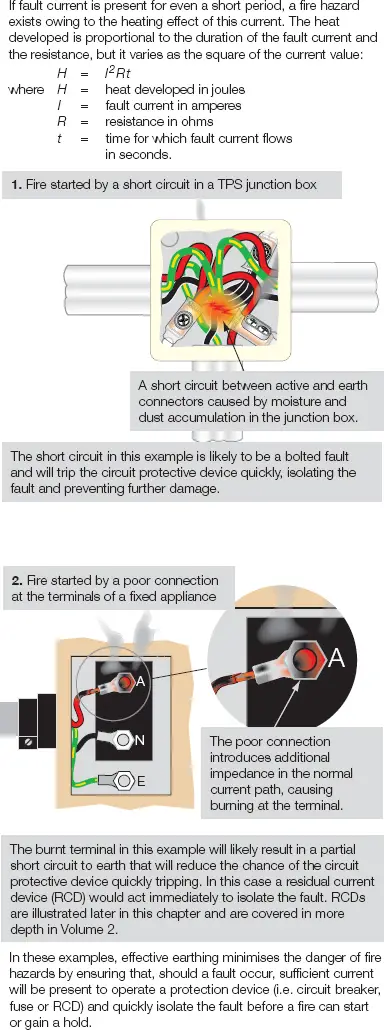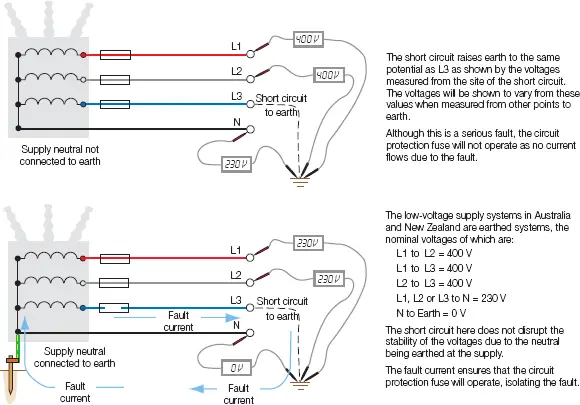A fundamental safety principle of electrical installations is the protection of persons and livestock ‘against the danger that may arise from contact with exposed conductive parts which may become live under fault conditions. The principal method used is the automatic disconnection of the supply, of which the Earthing system is an integral part.
Going about our normal day-to-day activities, we are in constant contact with the Earth’s conductive surface, so any rise in voltage between the Earth and exposed or extraneous conductive parts, such as the metal case of a washing machine, places a person who may touch the metal case at risk of electric shock (see Figure 1a).

Figure 1a Consequences of not having an earth wire connected to exposed conductive parts
Even when all materials for an installation are carefully selected and then carefully installed to comply with strict specifications and Wiring Rules requirements, the possibility of insulation failure in the wiring or equipment is ever-present. The failure of insulation immediately introduces hazards to life from electric shock and hazards to property from an electrically initiated fire.
Shock Hazard
The consequence of not having an earth wire connected to exposed conductive parts, such as the metal frame of an appliance, when a breakdown in insulation occurs is illustrated in Figure 1a.
If the Earthing is effective, it ensures that the entire Earthing system, which includes all exposed conductive parts and the metal frames of appliances, has a resistance value low enough to discharge effectively a fault current in such a manner that the voltage present will not be high enough to constitute a shock hazard. The voltage present at the moment the fault occurs between the live exposed conductive part and the general mass of earth is defined as the touch voltage. The Earthing system used in Australia and New Zealand is designed to limit the touch voltage in an installation to a value less than that of the nominal supply voltage. This is explained in Figure 1b.

Figure 1b Limiting the rise in touch voltage
Electrically Initiated Fire
The heat that develops in an electrical fault is sufficient to start a fire and is commonly cited in news reports as a possible cause of fires. The example given in Figure 1b is for a short circuit to earth fault that introduces no further impedance in the fault current path; it is as if the active conductor was bolted to the appliance frame, and is therefore known as a ‘bolted fault’.
However, short-circuit faults occur where the impedance of the fault prevents sufficient fault current from flowing to trip the protective device in the prescribed time. This type of fault is often referred to as a partial short circuit. A fire caused by a fault, whether it be a bolted fault or a partial short circuit, is an ever-present hazard owing to the heating effect of the fault current, as shown in Figure 1c.

Figure 1c Limiting the risk of fire
Voltage Stability
Another reason for Earthing is to ensure that the supply actives and neutral are maintained at a fixed and stable potential with respect to earth. This condition would not be obtained in an unearthed system, where a fault or standing leakage current could cause the potential of the Earthing system to ‘float’ or vary in value relative to other parts of the system.
Consider one type of fault that might occur, as shown in Figure 1d, in an unearthed system as compared with an earthed system.

Figure 1d Stabilizing earth potential in the supply system
Functional Earthing
The Earthing necessary for the correct functioning of some types of electrical equipment and not for the operation of over-current protection devices is defined as a functional earth.
Equipment such as that used for entertainment, communications and instrumentation is often affected by stray currents in an Earthing system and exposed conductive parts of this equipment.
These currents can induce voltages in the electrical circuits of the equipment, causing interference with its normal function. For example, unwanted noise in an entertainment system could be the result of poor functional Earthing; some types of residual current device use a functional earth.
The goal of functional Earthing is to eliminate any potential difference in the Earthing system or conductive parts associated with this equipment that may carry a current in normal use.
Often a star system of Earthing is used where all equipment is earthed at one point, so that there is no closed circuit within which a stray earth current could flow. Advice on the need for functional Earthing should be obtained from equipment manufacturers; however, the requirement for protective Earthing takes precedence over any functional Earthing. Figure 1e is an example of functional Earthing used to suppress or eliminate noise in the telecommunications equipment in a customer’s premises.

Figure 1e Example of functional Earthing